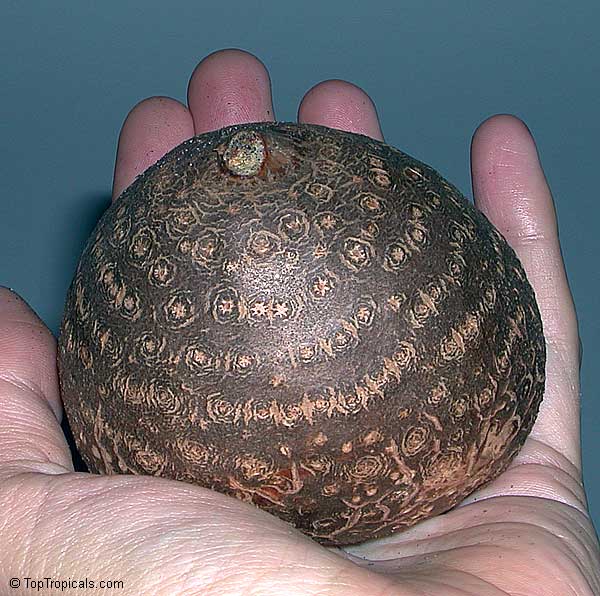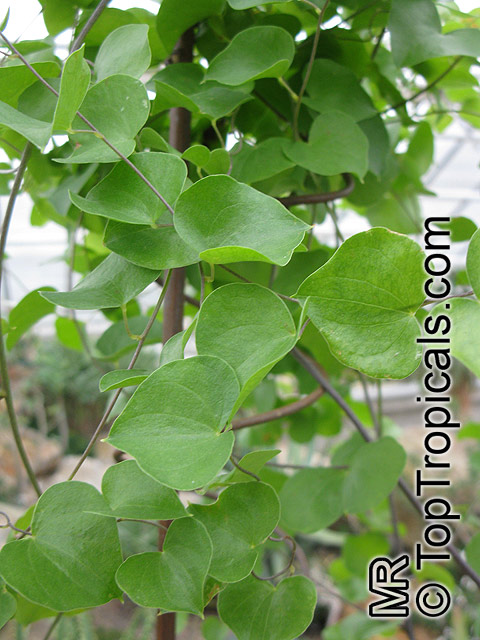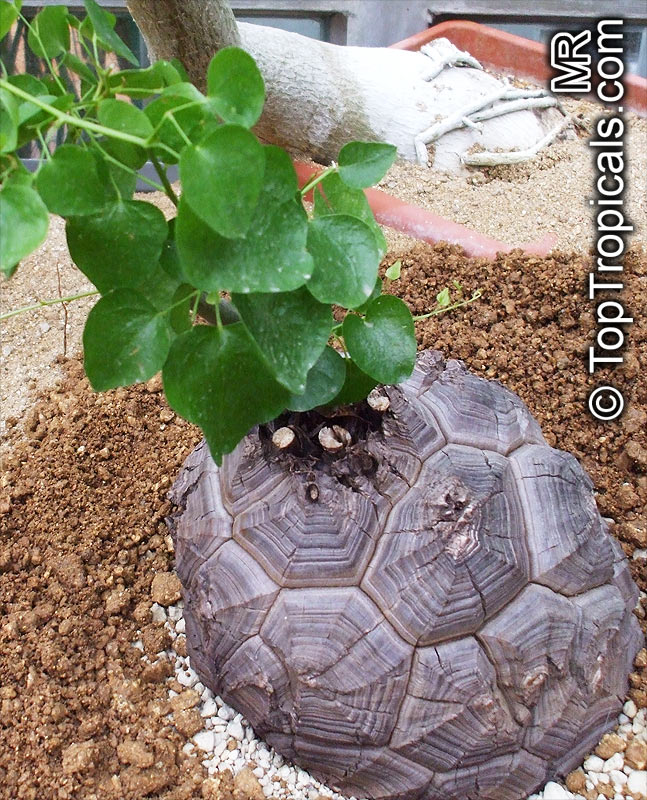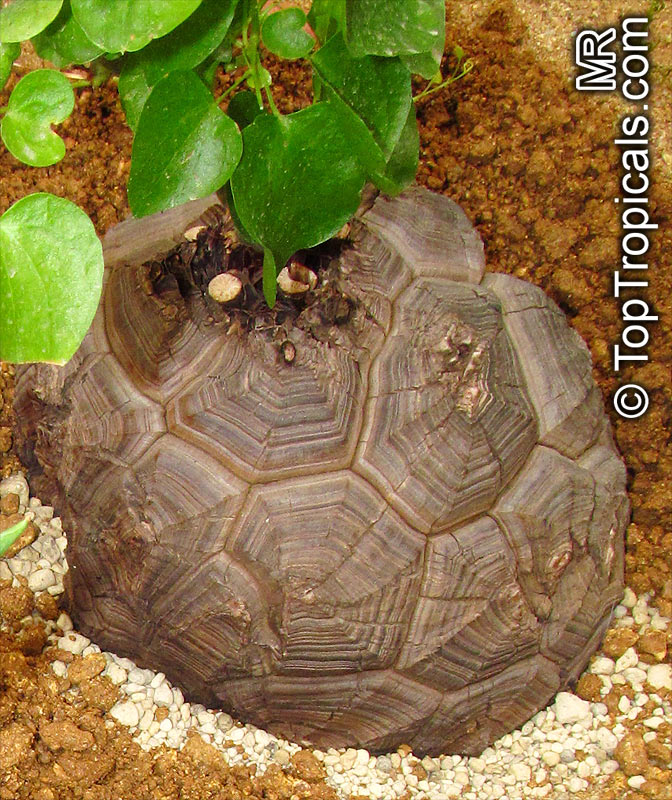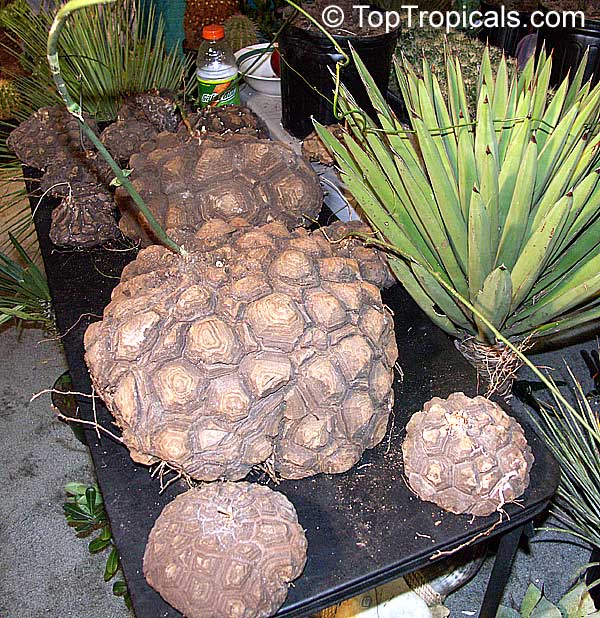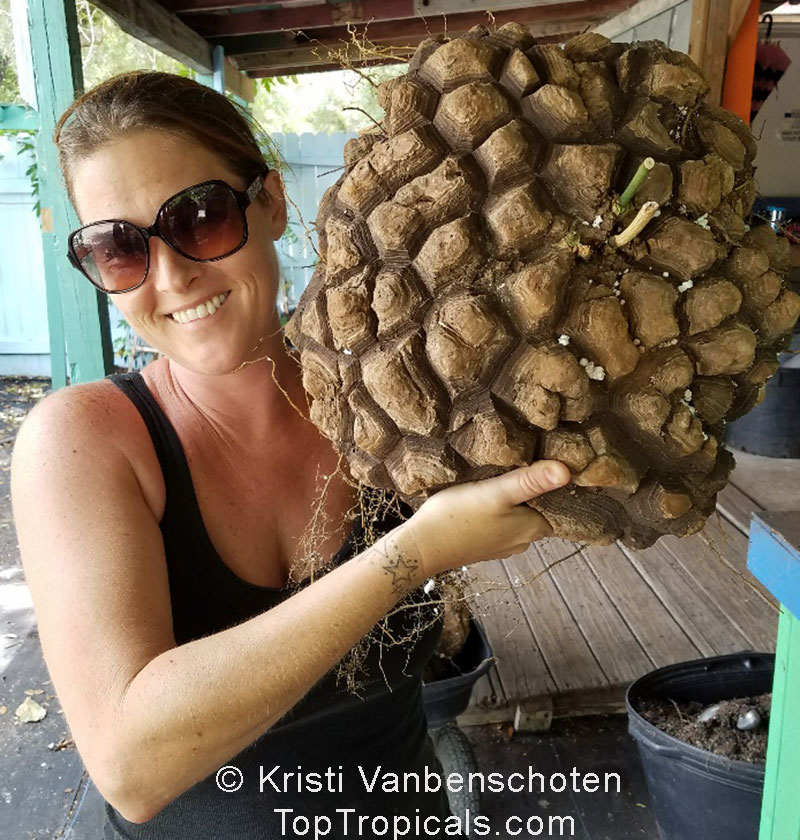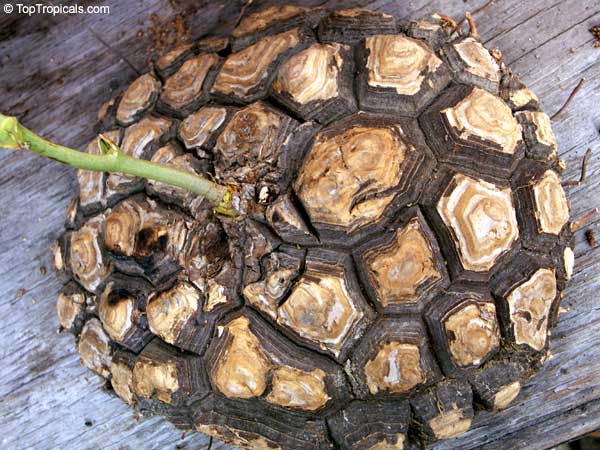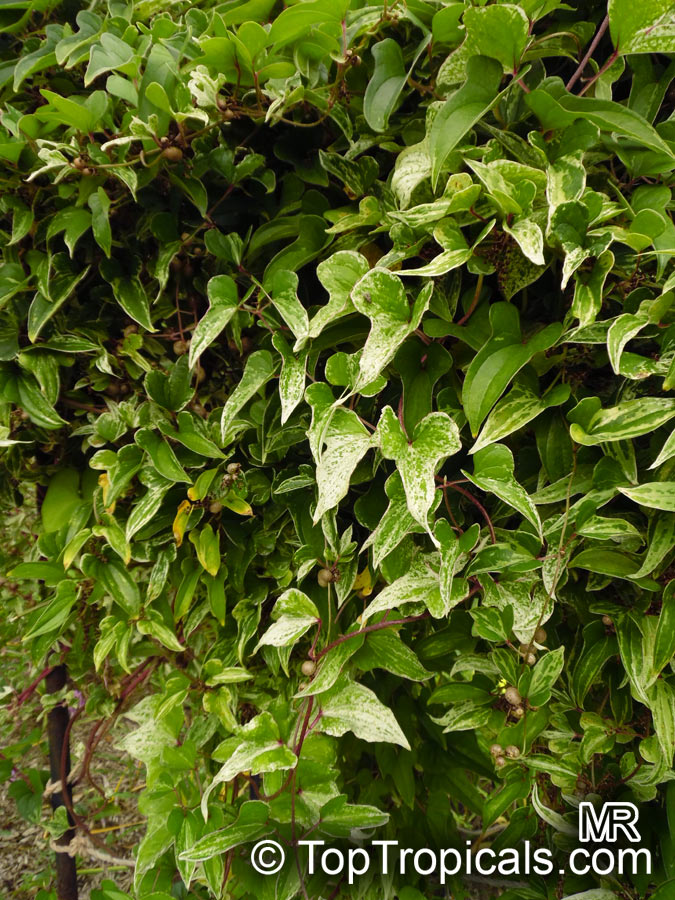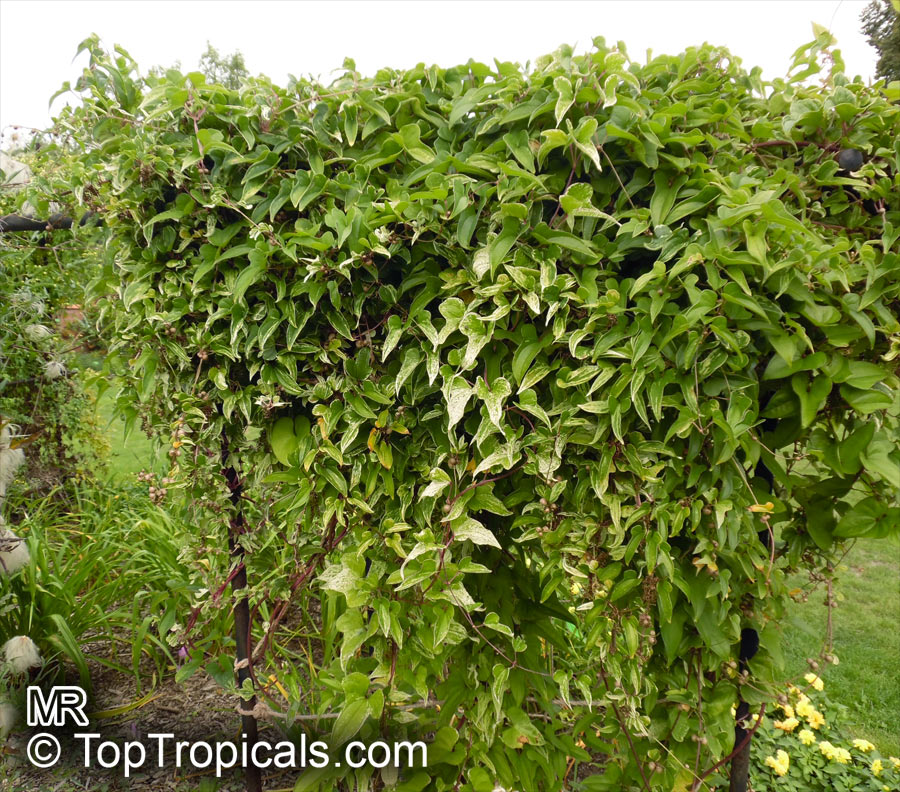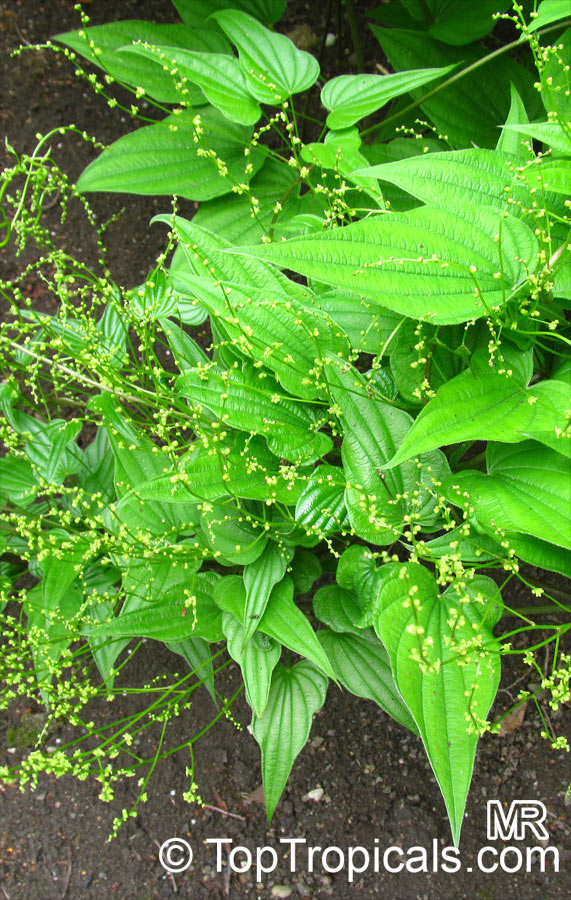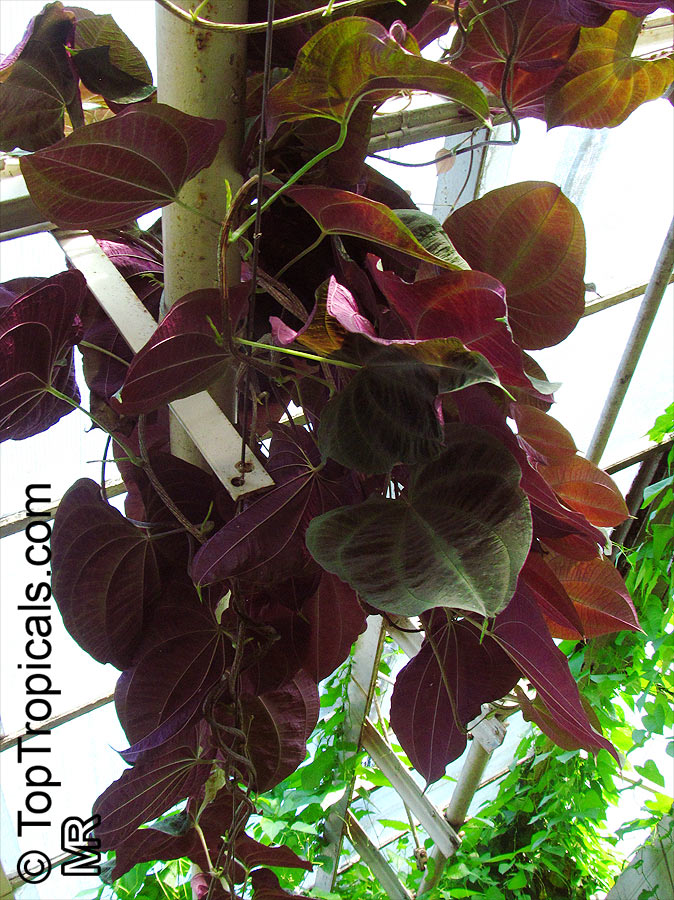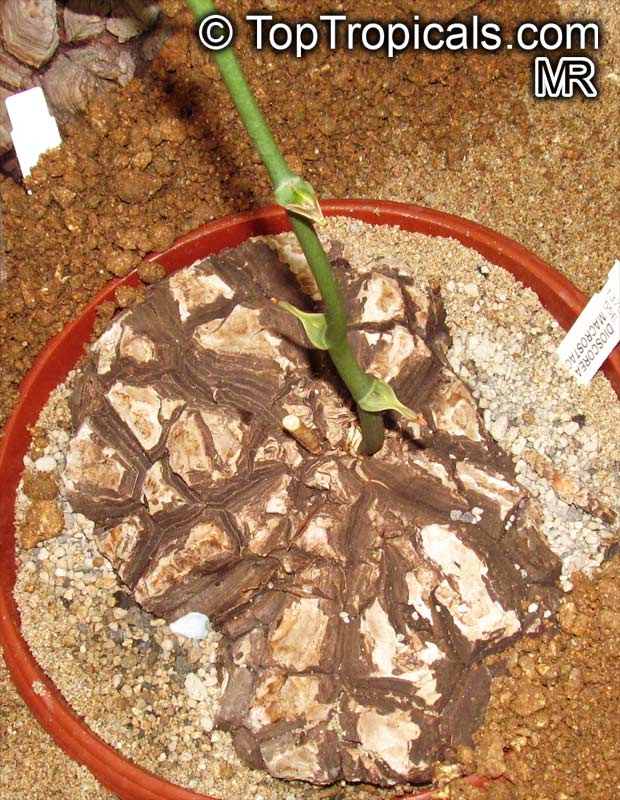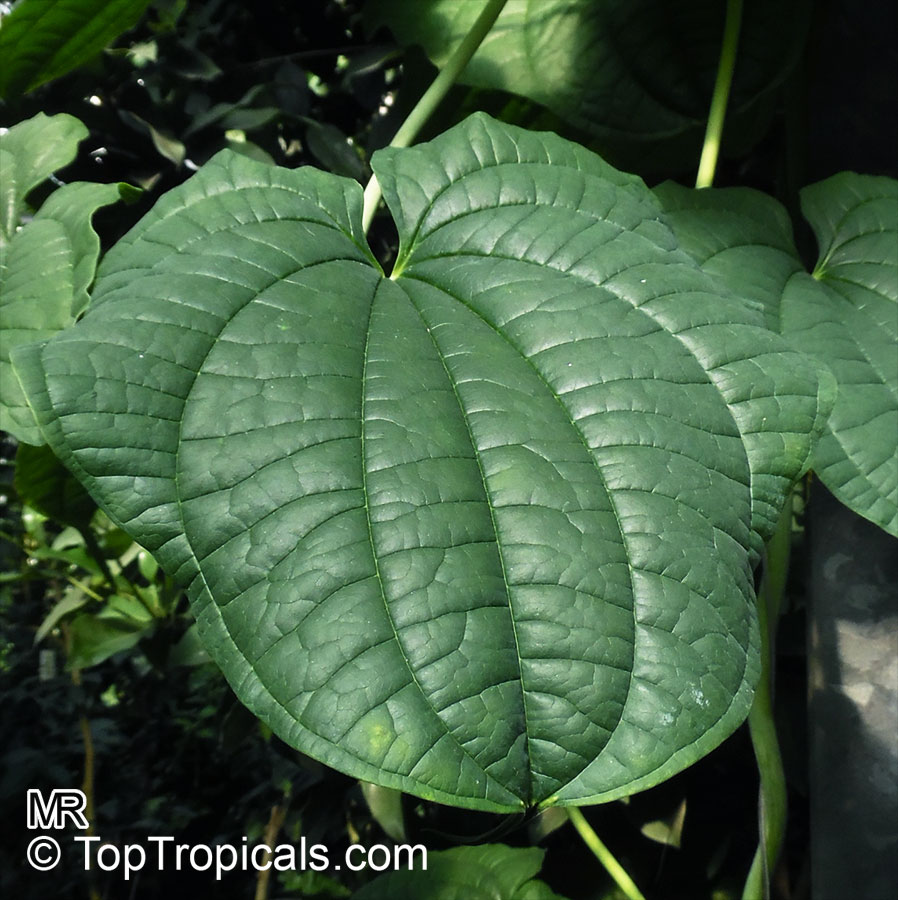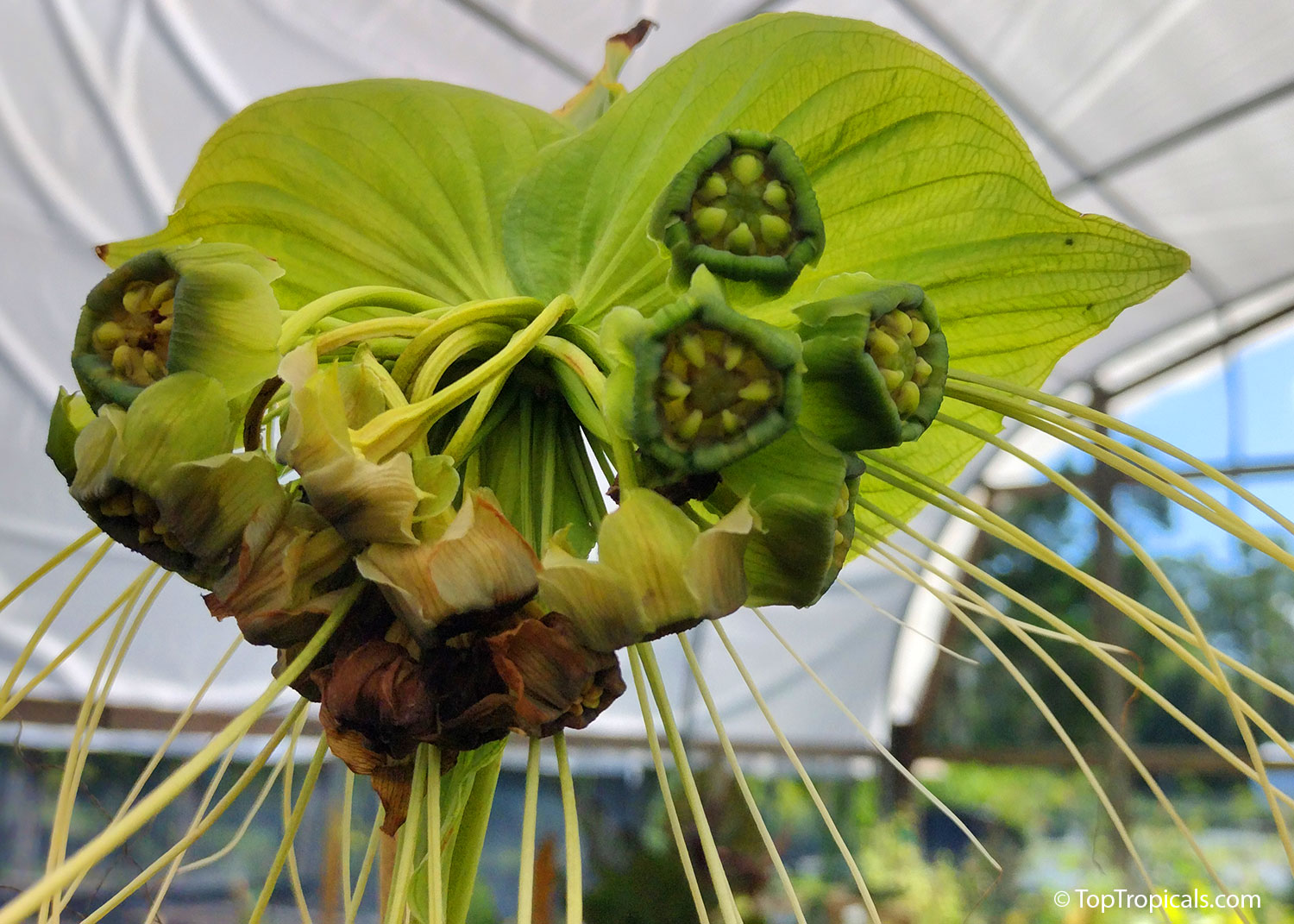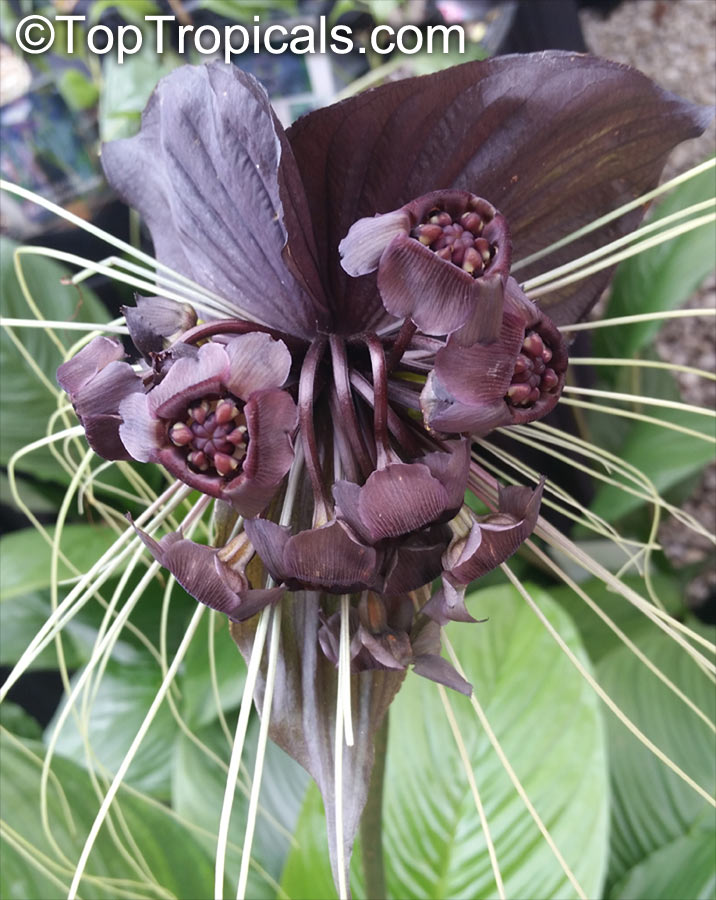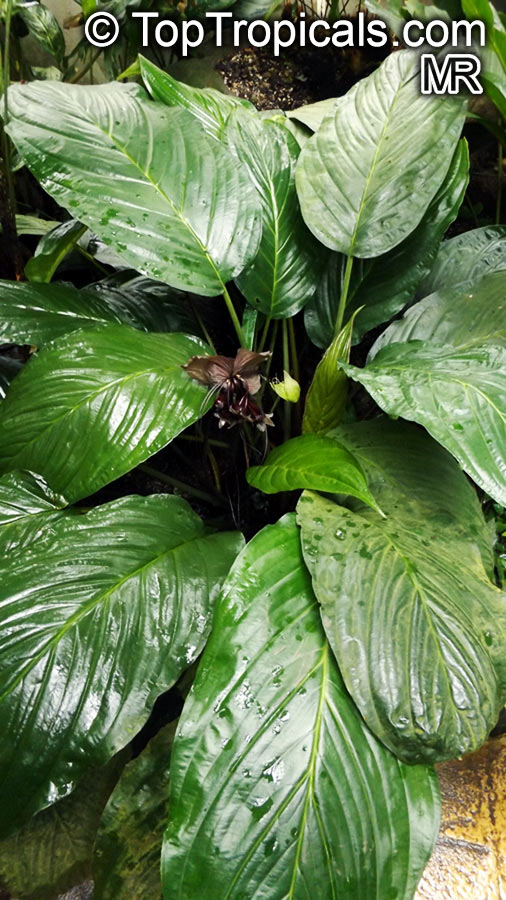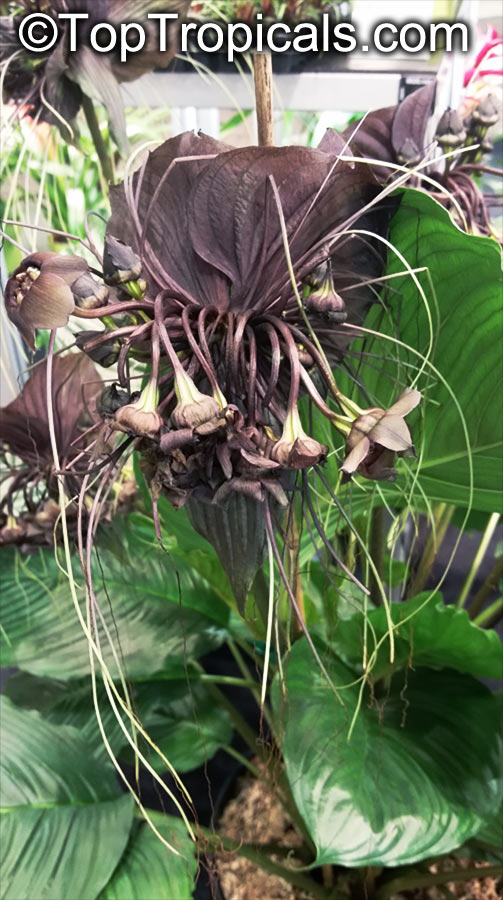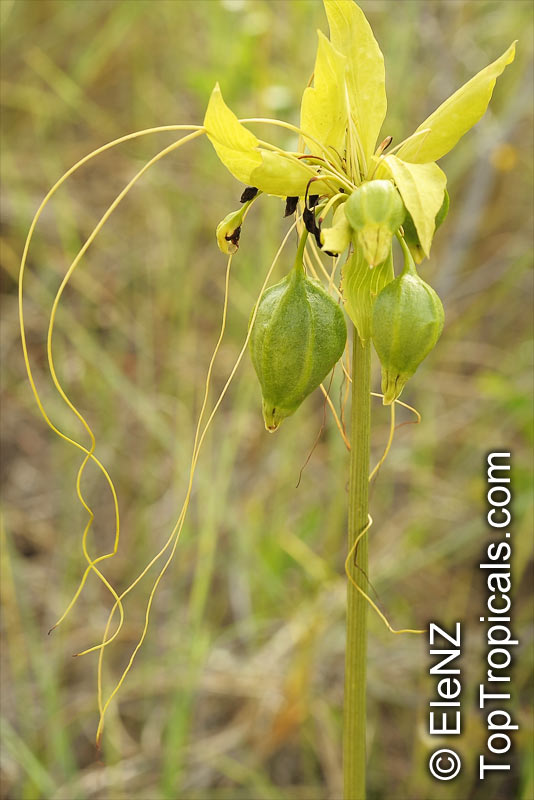Dioscoreaceae - Botanical Family
| Number of plants found: 11 | Next | 
|
Go to page: | 1 | 2 |
Botanical name: Dioscorea alata
Common names: Purple Yam, Winged Yam
Family: Dioscoreaceae
Origin: Southeast Asia







Dioscorea alata is a vine or creeper native to Southeast Asia. It requires full sun for germination and flowering, though it may also tolerate semi-shade. The plant needs regular watering and needs extra attention when in bloom and fruiting. Dioscorea alata is now grown in tropical areas in Southeast Asia and parts of Africa, including Ghana. In colder climates, it is usually kept in pots.
The plant has a winter dormant period during which its stems die back to the ground. Its underground tubers then give rise to new stems, which can reach up to 30 feet in length. The color of purple varieties of Dioscorea alata is due to various anthocyanin pigments, which have been proposed as potential food coloring agents. Wild plants, however, have been reported to be bitter or poisonous.
This ethnomedical plant is edible, both raw and cooked, and has been reported to have a range of therapeutic benefits. The fruits are edible when fresh, or dried and stored for future use. They may also be consumed as juice. Nutrition-wise, 100 grams of the purple variety contain 2.8 grams of protein, 51.3 grams of carbohydrates, 0.10 grams of fat, 3.7 grams of dietary fiber, and 10.2 g of sugar. It additionally has low levels of cholesterol and saturated fat.
Various health benefits are associated with Dioscorea alata, including improving vision and eye health, improving cholesterol levels, reducing blood sugar, and promoting digestive health. Its tuberous root is believed to be helpful for people with diabetes, as a decoction of it is used to treat diabetes throughout Latin America.
Gardens may be grown with Dioscorea alata for its ornamental value. Technically, the mature plant can withstand temperatures of up to 30 degrees Fahrenheit, though it is unlikely to survive much lower temperatures than that.
Botanical name: Dioscorea bulbifera
Common name: Air Potato
Family: Dioscoreaceae
Origin: Philippines










A perennial twining vine with edible roots. It has slender stems up to 6-15ft long that die out every autumn. Underground tubers, large, elongated, called, in its country of origin, sweet potatoes. Leaves dark green, lustrous, cordate, 7 to 9-veined are green or reddish-purple colored along the leaf margins, petioles, and stems. Flowers are small, white and have a cinnamon fragrance. In autumn small brown tasty, with a nut flavor edible bulbils appear in the axils of leaves. The lower part of the plant is very often devoid of leaves. Best grown in a warm sunny position. It's not fully hardy, hence before winter it's advisable to cover an area of about 40" in diameter around the plant with e.g. bark mulch thus creating an isolation layer that will help protect the roots. Thrives best in well-drained organic soil, rich in humus, and kept moist but not wet. An amateur plant, easy in propagation. Excellent for small fences, trellises and other garden supports. Widely cultivated in Asia for food, grown primarily as an ornamental in the US. Has proven to be root hardy to USDA Zone 5, persisting for years. Uses: The Chinese yam is a sweet soothing herb that stimulates the stomach and spleen and has a tonic effect on the lungs and kidneys. The tuber contains allantoin, a cell-proliferant that speeds the healing process. The tuber is also anthelmintic and digestive. It is used internally in the treatment of poor appetite, chronic diarrhoea, asthma, dry coughs, frequent or uncontrollable urination, diabetes and emotional instability. It is applied externally to ulcers, boils and abcesses. The tubers are harvested in the autumn and can be used raw or baked. The leaf juice is used to treat snakebites and scorpion stings. The roots of most, if not all, members of this genus, contains diosgenin. This is widely used in modern medicine in order to manufacture progesterone and other steroid drugs. These are used as contraceptives and in the treatment of various disorders of the genitary organs as well as in a host of other diseases such as asthma and arthritis. An easily grown plant, succeeding in a fertile well-drained soil in a sunny position or light shade, though it is best in full sun. Plants are hardy to at least -18c. Plants produce tubercles (small tubers that are formed in the leaf axils of the stems), and can be propagated by this means.
Uncultivated forms, such as those found growing wild in Florida, can be poisonous.
Botanical names: Dioscorea dodecaneura, Dioscorea discolor
Common name: Yam
Family: Dioscoreaceae
Origin: Brazil









Dioscorea dodecaneura, commonly known as Yam, is a vigorous, evergreen climber and vine that is native to Brazil. This ethnomedical plant is known for its decorative foliage and edible fruits, making it a highly desirable ornamental specimen and useful garden addition. In its native habitat, it can be found in full sun to semi-shaded conditions, generally climbing on trees, shrubs or rocks.
It grows best in rich, moist soil and benefits from regular water, but can tolerate short periods of drought. It can be grown in USDA zones 9-11, but should be protected in the colder months, such as winter and early spring. When grown in a pot, extra care must be taken to protect it from temperatures below freezing.
The leaves of the Dioscorea dodecaneura are a glossy, deep green and it produces pendant racemes of small yellow flowers during spring and summer. These are followed by an abundant crop of yellowish-white, oblong fruits that have a sweet, aromatic flavor. These fruits are edible and they are traditionally used in Brazil as a food source. They are also known to have multiple health benefits, such as being high in antioxidants and vitamins. Each plant can produce up to 30 fruits each year.
Dioscorea dodecaneura is an easy to cultivate plant, with a high ornamental value and edible fruits. It makes a great addition to gardens, and its long-lasting, glossy foliage and fragrant flowers will attract hummingbirds and pollinators. With proper care, it is sure to be a highlight in any landscape.
Botanical names: Dioscorea elephantipes, Dioscorea macrostachya, Dioscorea mexicana, Testudinaria elephantipes
Common names: Elephant foot, Turtle shell, Hottentot-Bread
Family: Dioscoreaceae
Origin: South Africa











Curious plant with tuber is above ground level covered with layers of corky bark, resembling a caudex. Slow-growing. It is a very unusual succulent. Its main feature is a large, corky caudex that grows up to one meter in habitat, resembling an elephant foot (hence the popular name). The caudex looks as if it is segmented into geometric patterns (smaller plants look like tortoises) and looks dead but is actually a living tuber. A plant with a 18" caudex can be 75 years or older. The plant grows into a vine with attractive heart-shaped leaves and small yellow flowers. Culture is relatively easy. A greenhouse is great, but a windowsill with moderate to full sun works fine, as long as the plant is kept at 65F minimum. The vines may die back and regrow several times a year, depending on the particular plant and your region. Several plants in the same pot can go dormant in different times. Tuber contains saponins, originally cooked and eaten as a famine food by the Hottentots. Slow down water when the tuber is dormant. The plant is is dioecious (male and female flowers are produced on different plants). The 0.2 inches wide (4 mm), greenish-yellow flowers are insignificant. Seeds are the only way to reproduce. The seedlings caudex forms below ground and will grow much faster if left underground for a couple of years. Prefers filtered light, and the caudex must be kept in shade. Elephant Foot is a collectors item, but remarkably easy to grow. It will be with you for years with no effort. It is a wonderful conversation piece!
Growing directions (by Ed Sienkiewicz)
D. elephantipes doesnt send down deep roots, so plant in a shallow pot (I use clay bulb pots) about 1" larger than the diameter than the caudex. Potting soil should be very porous/loose so that there is easy drainage. Think about the area in which they grow natively. Remember that these plants are tropical DESERT plants. The soil should be very loose and drain very freely. Allow the soil to come up and slightly over the edge of the caudex 1/4"- 1/2" so that the edges are covered. Water well around the edges, being sure not to get water into the point from which the vine will grow (usually there some pieces of old vine in the growing area). Keep in a warm area and wait for the first shoots of the vine to appear. Water regularly from that point on. Use dilute (25 percent of normal) fertilizer with each watering. The plant should not be kept damp as with other tropical plants. Allow it to *almost* dry before watering again. The plant has natural dormancy period. That being said, however, my experience is that the plant will go dormant when *IT* wants to. If the vine begins to yellow and die back, limit the water and stop the fertilizer. If the vine dries up cease all water and move to a cool place for a couple of weeks. Return to a sunny area and wait for the vine to sprout again. NOTE: Many books will say that they are winter growers, because they are native to the southern hemisphere. In my experience they are opportunistic growers. I have had them grow in all seasons. I have had plants that went dormant for a couple of weeks and others who were dormant for months. Let the plant be your guide. You cannot force them to grow, and over watering will simply cause them to rot. The Dioscorea elephantipes caudex is similar to Dioscorea mexicana, but the individual "squares" are far more pointed/raised. Related species - Dioscorea macrostachya (Mexico).
Botanical names: Dioscorea polystachya, Dioscorea batatas
Common names: Chinese Yam, Cinnamon-vine
Family: Dioscoreaceae
Origin: Eastern Asia










The flowers of Dioscorea polystachya will appear between early July and early September and positively announce the bearing of edible fruit.
Dioscorea polystachya, commonly known as the Chinese Yam, is a perennial vine native to Eastern Asia. It is grown in USDA Zones 9-11 and is considered a vigorous vine, since it can grow up to 20 ft long, with burgundy colored stems and yellow-orange flowers with a sweet and pleasant scent.
It can tolerate full sun, but it needs regular watering. It is also tolerant of moderate amounts of water so does not need to be watered more than once a week.
The Bulbils of the Chinese Yam are also edible. They are an important food source in China and have been documented in Ethnomedical traditions. The fruit of the Chinese Yam is edible and can be eaten raw or cooked, and is known for its many health benefits including reducing inflammation, reducing blood sugar levels, aid digestion, and nourish the lungs and spleen.
The Chinese Yam can produce a large amount of fruit in each season, making it quite a valuable crop. Each season it can produce dozens of fruits ranging in size and shape, which can be harvested when they reach full maturity.
In cold regions where the temperature drops below 30°F, growing the Chinese Yam in a pot may be a better option. In this context, it is essential to have well-draining soil and to water the plant regularly.
Botanical name: Dioscorea sp.
Common name: Yam
Family: Dioscoreaceae







Yam (Dioscorea spp.), is widely cultivated in tropical regions and serves as food in Central and South America, in Africa, Asia and in the Pacific Islands. The Dioscorea genus contains more than 600 species, 14 of which have edible tubers.
Species:
Dioscorea caucasica -Caucasus Yam Root
Dioscorea hemicrypta - ornamental caudex plant with semiperennial to perennial vines with small, heart shaped leaves and small, axillary yellowish flowers.
Dioscorea mexicana
Dioscorea rotundata, D.cavensis, D. esculenta -Came Blanco, Nyame, Yam. The most popular yam in West Africa.
Dioscorea rupicola
Dioscorea sylvatica (Testudinaria sylvatica) - caudex plant from South Africa, related to Dioscorea elephantipes.
Botanical name: Tacca chantrieri
Common name: Green Isle Bat Head Lily
Cultivar: Green Isle
Family: Dioscoreaceae
Origin: Southeast Asia, West Africa, Hybrid





Rare variety of Tacca chantrieri - Green Isle. This amazing bat plant has green blossoms with long showy whiskers. It is the same species as the black bat plant but this bright green blossom is quite the spectacle. This rare plant will stop passers by in their tracks. This breath taking tropical blooms from late Spring to early Fall and like to live in a spot where it gets about 60 percent shade. This plant is a good choice as an indoor potted plant since it does well in containers and in semi shade. They like to drink a great deal of water and bask in high humidity.
Curious, bat-like inflorescence, with wide spreading, wing-like bracts, accompanied by long trailing filaments or 'whiskers'.
Botanical name: Tacca chantrieri
Common names: Bat Head Lily, Bat Flower, Devil Flower, Black Tacca
Family: Dioscoreaceae
Origin: Tropical regions of Southeast Asia and West Africa






Curious, bat-like inflorescence both in shape and color, with wide spreading, wing-like bracts of rich maroon-black, accompanied by long trailing filaments or "whiskers". The small black flowers are succeeded by heavy berries, corrugated olive-green leaves with oblique base. These are interesting, evergreen, perennial and herbaceous plants that grow wild in many tropical climates. They can be grown in humid, tropical greenhouses. See page about Tacca.
Botanical name: Tacca leontopetaloides
Common names: Green Bat Flower, Polynesian Arrowroot
Family: Dioscoreaceae
Origin: Asia, Australia, Pacific Islands
Hardiness: 35°F








Tacca leontopetaloides, also known as the Green Bat Flower, thrives in shady or semi-shaded areas and requires regular or moderate amounts of water. It is native to Asia, Australia, and the Pacific Islands and is cultivated in USDA Hardiness Zones 9-11. It is a small plant, growing 2-5 ft tall, with glossy, dark green, divided leaves and an unusual, intricate, deep-purple-black flower. The flower has a yellow-green center and long, trailing bracts.
When growing Tacca leontopetaloides, it is recommended to pot the plant in soil with good drainage. During the summer, water lightly and fertilize once with a balanced liquid fertilizer mix. During the winter months, water less frequently and reduce fertilizing. If you live in a cold region, it is advisable to bring the plant indoors during cold winter months.
Tacca leontopetaloides is known for its ethnomedical properties and for its ornamental value. It has been used to treat various ailments such as fever and to relieve muscle pain.
In conclusion, Tacca leontopetaloides is a small shrub that requires minimal maintenance. It is easy to grow, in shady or semi-shaded areas, and requires regular or moderate amounts of water.
Botanical names: Tacca nivea, Tacca integrifolia
Common names: Bat Head Lily, Bat Flower, Devil Flower, White Tacca
Family: Dioscoreaceae
Origin: Malaysia





Curious, bat-like maroon-black inflorescence both in shape and color, with wide spreading, wing-like white bracts, accompanied by long trailing filaments or "whiskers". The small black flowers are succeeded by heavy berries, corrugated olive-green leaves with oblique base. These are interesting, evergreen, perennial and herbaceous plants that grow wild in many tropical climates. They can be grown in humid, tropical greenhouses. See page about Tacca.
| Next |  |
Use link to repeat this search:
https://toptropicals.com/cgi-bin/garden_catalog/cat.cgi?search_op=and&keyword_op=and&language=e&family=Dioscoreaceae
&number=10&no_change_lang=1&user=tt&sale=1&first=0














